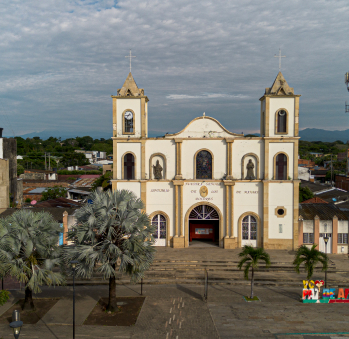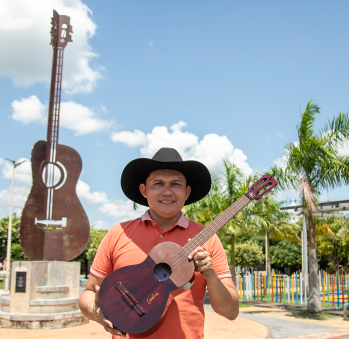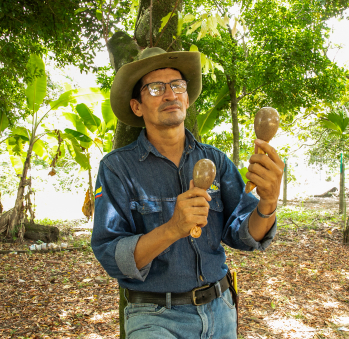Casanare Route
There are people proud of their origins, and Casanareños are at the top of that list. Their voices resonate when they speak of their rural past, and they carry it like a banner firmly planted in the ground as the foundation of who they are. What’s truly beautiful is that they keep this spirit alive in something they call “La Llaneridad,” a heartfelt connection they generously share with anyone willing to explore it. It all begins with preserving the richness of their language. For them, there’s nothing more beautiful than narrating the story of their land to the tune of a cowboy song; verses that sing to the plains and the work of those men who used to lasso, brand, and wrangle cattle from one place to another.
They also preserve the traditions stemming from this fieldwork—dancing joropo, playing the cuatro, harp, and maracas, singing, carrying the pollero, a bag containing provisions or bastimento, the delicious Llanera lunchbox with wheat cakes, dried meat, plantains, tungos or rice-wrapped snacks, and gofio or corn and panela sweets—a snack to endure the grueling day of horseback riding. The ultimate reward is stretching out on a chinchorro or, if you desire more, on a campechana, a leather hammock woven with care, an elegance in which you must lie down at least once in your life.
These men and women in love with their land have a thousand stories to share, including the artisans we invite you to visit, all of them masters preserving the traditions of their people. An intriguing aspect of this place is that even if you weren’t born in Casanare, you can become a part of it. The fact is that this department often welcomes newcomers, and many have found not only work but also a place to set down roots. Our artisans, magnificent representatives of these migrations, will tell you more about this.
Of course, this description wouldn’t be complete if we didn’t mention the natural wealth of this paradise, where birdwatching, jaguars, deer, and capybaras are part of the landscape. Imagine an extensive journey where you’ll encounter all a variety of climates, and along the path we propose, we invite you to visit Yopal, Paz de Ariporo, Tauramena, Aguazul, and Villanueva, all municipalities with a strong artisanal tradition. In their surroundings, you’ll discover many incredible cultural and ecotourism plans. Travel to Casanare; it will be an unforgettable trip.
Embark on a journey full of history

Artisans along the way
Artisans along the way
We recommended this tour
Schedule the visit in advance with the artisans.
Carry cash
Travel in summer season (December - April)
6 days
Car or bus
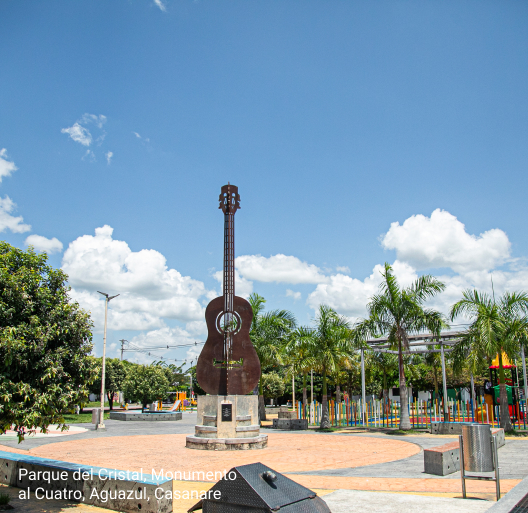
Yopal
Yopal, the capital of the department, is a municipality founded in 1915 as part of an ongoing quest to uncover its colonial roots and reveal its significance during the liberation campaign. In fact, archaeological work in the village of El Morro, bordering Boyacá, has uncovered old royal roads. In Matelimón, its community recreates these exploits in rich oral tradition. To delve into this history, visit the Historical Museum of the East in the city center, which is known as the most comprehensive museum of the Colombian Orinoquia region. If you wish to understand the deep connection to the Llanos, there are several options for visiting traditional farms, where you can learn about lifelong fieldwork, myths, and legends. July 25 is Llaneridad Day, and the whole city celebrates. To explore the local music, don’t miss the International Festival of Contrapunteo and Voz Recia “Cimarrón de Oro,” which takes place in the second week of December. If you visit at another time of the year, drop by the GHL Style Yopal Hotel on Thursday afternoons for traditional musical performances. If you plan your trip during Holy Week, be sure to attend the National Hayaca Festival—it’s a true delight. Here, as part of your journey, visit the artisans on this Map: weavers Leonilde Peña and Ester Martínez, carver Juan Miguel Molina, and the Barragán brothers, musicians known for making maracas, following in the footsteps of the famous Guadalupe Salcedo.
YOPAL - PAZ DE ARIPORO - YOPAL
Paz de Ariporo is located 92 kilometers north of Yopal, and it’s home to master campechana craftsman Hermes Romero and totumo artisan Lorena Vanegas. Before arriving there, make a stop in Pore (72 km), the birthplace of famous llanero singer Cholo Valderrama. Paz de Ariporo is renowned for its pilgrimage to the patron saint, the Virgin of Manare; its patron saint festivities on January 6 are truly unique. During Holy Week, they host the Trompo and Zaranda Festival, celebrating traditional children’s games. A recommended plan is to visit Hato La Aurora, a reserve where you can observe jaguars, deer, capybaras, and numerous bird species (enter through the La Cristalina entrance). You can also experience llano work and learn about horseshoeing, enjoy mamona, a regional dish, and listen to cowboy songs. Locals recommend trying cerdo al hoyo and the traditional pisillo, dried and ground meat, pira, similar to pisillo but in small squares, which is used in sopa de pira.
YOPAL — AGUAZUL
Now, your journey takes you south. Aguazul, located just half an hour from the capital (26 kilometers), is the place where we want you to visit Fredy Landines, a luthier who crafts cuatros. The Laguna del Tinije and the Farallones Trail are known attractions in the area, and birdwatching is one of the highlights. In addition to rice cultivation, a popular local beverage is guarruz, or rice and cheese porridge. When it comes to food, you must visit Doña Emelina Ríos at La Cocina de la Mamá Señora (Santa Mónica farm) to taste traditional dishes prepared with old-time recipes and flavors. An unforgettable character to meet is Mr. Argemiro Pirabán, the llanero cowboy, a man who embodies pure Llaneridad. Watching him lasso, wrangle, and ride is a unique experience.

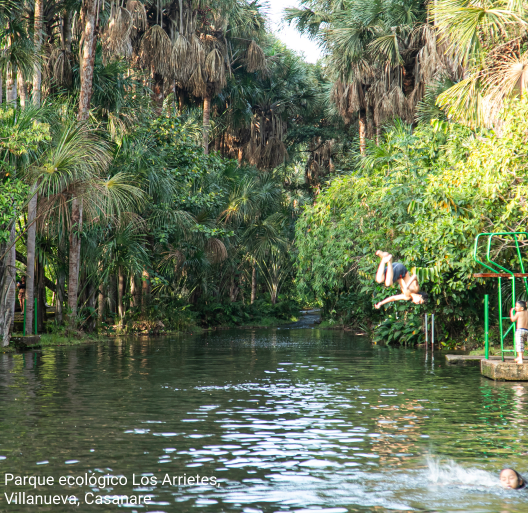
TAURAMENA - VILLANUEVA
Sixty-four kilometers from Yopal, this landscape is characterized by foothills and mountains, offering a chance to experience a true llano safari at Hato Barley, an ecotourism immersion site. You can see the Farallones of San Miguel from the mountains of the municipality. A notable attraction in the area is the replica of Noah’s Ark, a massive wooden structure over sixty meters long. There are also natural pools. In March, you can attend the International Rodeo Festival, a folkloric and musical event featuring the best llanero musicians, both national and from neighboring Venezuela. Here, we want you to meet Avelino Moreno, a musician and luthier who can talk for hours about music and llanero culture. Try his dehydrated pineapple and the local coffee. Now, head to Villanueva, an hour from Tauramena, where you can find comfortable lodging. There, you can visit Martha Yaneth Rojas, a paper mache artisan. This municipality is known for its palma de moriche, a native palm that reflects the many colonies living in the area (the Colonies Festival in mid-August is famous). They offer a wide variety of plans: religious and healing tourism at the Virgen del Caracolí, birdwatching, ecotourism trails (Aguaclara route), forest landscape (San Pedro route), lagoons, and a river tour (Santa Helena route).
Traditional cuisine
and typical bites
Provoke yourself

Don't leave without eating this 
La mamona o ternera a la llanera es un asado de carne tierna de becerra que se sazona con sal y cerveza. Se ensarta en varas de cubarro, una palma espinosa, y se cocina alrededor de una hoguera con mucha brasa. Se acompaña con yuca, topocho (un tipo de guineo) y plátano maduro. Es el plato más emblemático del Llano y se suele preparar en ocasiones especiales como festivales ganaderos o ferias. Disfrútala en La Mamona, en los asaderos La Llanerita, Aquí es Purrundun y El Ranchon de las Carnes, entre otros.
To lunch we go 
- El sancocho de pato pelón llanero es un caldo espeso de pato, arroz, yuca, cebolla, ajo, sal, cilantro y comino. Se cocina a fuego lento hasta que el pato esté suave y el arroz se deshaga. Se sirve caliente con arepa o pan. Se puede disfrutar en temporada en el Piqueteadero La Gallina Borracha, en Villanueva.
- El cachicamo asado es una preparación exótica que consiste en asar un cachicamo, un animal parecido al armadillo, sobre brasas. Se le quita el caparazón y se sazona con sal, pimienta, ajo y cebolla. Se puede comer con las manos o con cubiertos. Aunque este animal se considera como carne de monte es habitual encontrarlo en los estaderos de la zona.
Flavors to discover and snack on 
- Los tungos son un plato típico de la gastronomía tradicional del departamento del Casanare. Se trata de unas tortillas de maíz o de arroz rellenas de queso y envueltas en hojas de plátano, que se cocinan al vapor o al horno. Los tungos se pueden acompañar con carne asada, chorizo, chicharrón o cualquier otro producto cárnico de la región. Pueden ser de sal o de dulce, siendo estos últimos adobados y aliñados con panela y canela.
- La hayaca criolla es un tamal de maíz relleno de carne de res, cerdo o pollo, arvejas, zanahoria, papa, huevo duro y aceitunas. Se envuelve en hojas de plátano y se cocina al vapor. Se suele comer en Navidad o Año Nuevo, aunque en el Piqueteadero Bambú, en el municipio de Paz de Ariporo, se encuentran de manera permanente.
To sweeten the palate and unmissable drinks 
- El arequipe de yuca es uno de los dulces más tradicionales de los Llanos, sobre todo en esta región donde lo preparan con yuca, un tubérculo muy versátil y nutritivo. El arequipe de yuca se hace cocinando la yuca con leche hasta que quede una mezcla espesa y dulce. Es ideal para los que no pueden consumir mucha azúcar, ya que la yuca le aporta un sabor natural. Puedes comerlo solo o acompañado de queso o pan.
- El dulce de leche es otro clásico de la repostería colombiana, que se consume en todo el país y también en la región de la Orinoquía. El dulce de leche se elabora con leche y azúcar, a los que se les puede agregar vainilla o bicarbonato para darle más sabor y consistencia. Muy famoso en Lácteos Villa Carola.
- El dulce de marañón o acajú es una fruta exótica que se da en esta zona del país, y que se conoce por su particular apariencia. El dulce de marañón se hace cocinando los marañones hasta que estén blandos, y luego se les agrega azúcar, canela y clavos. El dulce debe quedar con una consistencia pegajosa o amelcochada, y tiene un sabor agridulce muy especial. Puedes comerlo solo o acompañado de queso o pan.
- El dulce de papaya o lechosa es otra fruta muy común en la región de la Orinoquía, que se usa no solo para hacer jugos, sino también para hacer dulces. El dulce se hace con trozos de papaya verde, una pizca de bicarbonato, panela, agua y clavos de olor. Se deja cocinar hasta que la papaya esté suave y el líquido se haya reducido a un almíbar espeso y oscuro. El dulce tiene un sabor dulce y perfumado, y puedes comerlo solo o con queso o crema.
- Entre las bebidas más populares se encuentran la limonada llanera, que se hace con limones verdes, panela y agua; el guarapo, que es un jugo fermentado de caña de azúcar; y la cerveza, que acompaña a la mamona o ternera a la llanera. Hay que disfrutarlas en Guarulo, junto con todas sus delicias.
- Sin embargo, hay una bebida que es muy especial y que no se encuentra en cualquier parte: el topochillo. Esta bebida viene del interior de Casanare, muy adentro de los Llanos Orientales, y su ingrediente principal es el topocho (guineo). Su origen viene de los indígenas chiricoas, que lo consumían como sopa. Se prepara con topochos maduros que se pelan y se ponen a cocinar en agua hasta que se deshacen. Luego se cuela el líquido y se deja fermentar por varios días en un recipiente tapado. El resultado es una bebida espesa, dulce y alcohólica, que se sirve fría o caliente, según el gusto. El topochillo es una bebida verdaderamente artesanal, que representa la tradición y la cultura del Casanare. Es una bebida que hay que probar al menos una vez en la vida, para conocer el sabor auténtico de los Llanos Orientales.
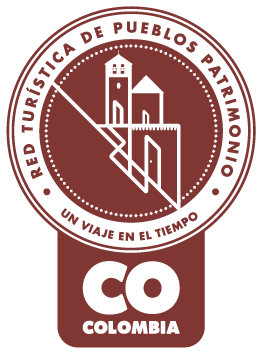
Pueblo Patrimonio
La Red Turística de Pueblos Patrimonio de Colombia es un programa especial del Ministerio de Comercio, Industria y Turismo, ejecutado por FONTUR, que trabaja con 17 municipios de Colombia que poseen declaratoria de Bien de Interés Cultural (BIC) a nivel nacional para su valoración y proyección mediante el turismo, generando así más oportunidades de desarrollo y sostenibilidad en las comunidades.

La Medalla a la Maestría Artesanal es un galardón que Artesanías de Colombia entrega anualmente, con el cual se hace un reconocimiento a aquellos artesanos, empresas y comunidades artesanales que, contando con una trayectoria destacada, sobresalen a nivel nacional por su excelencia en el oficio así como por preservar el quehacer artesanal.

Denominación de Origen
Es un signo distintivo que identifica productos reconocidos o famosos por tener una calidad o características específicas derivadas esencialmente del lugar de origen y la forma tradicional de extracción, elaboración y producción por parte de sus habitantes. La protección conferida sobre una Denominación de Origen implica que ninguna persona puede identificar con la denominación protegida productos iguales o similares a los amparados, cuando no provengan del verdadero lugar y no cumplan con las características o calidades que le han dado la reputación al producto reconocido. Las Denominaciones de Origen para productos artesanales colombianos que han sido protegidas por la Superintendencia de Industria y Comercio en nuestro país son actualmente 12.
No puede copiar contenido de esta página













































